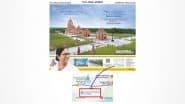Shillong, May 1 (PTI) The Meghalaya Cabinet on Thursday decided to implement the vehicle scrappage policy to reduce air pollution in the state.
The cabinet meeting was chaired by Chief Minister Conrad Sangma.
Addressing media persons after the cabinet meeting, Meghalaya government spokesperson Paul Lyngdoh said, "Old dilapidated cars, which are no longer road-worthy will come under this policy. Altogether, 13,000 vehicles in Meghalaya will be off the road as per this new policy. Of this, 5,000 are government vehicles and 8,000 are private owned vehicles."
He said the major benefit of having this policy is to allow the government to reduce the pollution level through less emission, reduce fuel import, which means less extraction and recycling of raw material.
"At the moment, Shillong has roughly 2,76,262 vehicles followed by Tura and Jowai. We will now start addressing concerns relating to air pollution caused by inefficient and old vehicles," Lyngdoh said.
"Taking into account the overall economic condition of the people of the state, we will address the matter by first taking off government vehicles, which are 15 years and older. This will roughly mean that around 5,000 government vehicles will come under this scrappage policy and therefore, will be off the road," he said.
"Where private owned vehicles are concerned, we have decided to first implement by limiting this policy only to vehicles, which are 35 years and older and there are roughly 8,000 such vehicles," Lyngdoh said.
The Central Pollution Control Board had recently declared Byrnihat town along the interstate border as the most polluted urban centre in the country for the second year in a row with an AQI of 302 putting it in the category of "very poor".
The cabinet has also approved a proposal to upgrade six government secondary schools to higher secondary schools and addition of new streams in 11 higher secondary schools.
The decision was necessitated following the high pass percentage of candidates appearing for the secondary school leaving certificate in which about 12,000 seats were short, Lyngdoh said.
"In all, six government secondary schools will be upgraded to higher secondary schools and 11 schools, which do not have certain streams will now have new streams," he said.
"The total financial implication for the introduction of these new streams and the upgradation of public schools from secondary to higher secondary schools will cost the government's exchequer roughly Rs 10.81 crore per annum," he said, adding that 137 posts of teachers will be created for the 17 schools.
Lyngodh said the decision was taken as there was a deficit in the intake capacity at the eleventh standard, which stands at 12,000 seats and there was also disproportionate concentration of higher secondary schools, mostly in urban areas of the Khasi Jaintia Hills region.
(This is an unedited and auto-generated story from Syndicated News feed, LatestLY Staff may not have modified or edited the content body)













 Quickly
Quickly














